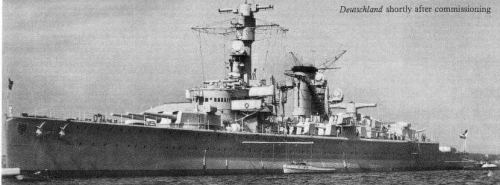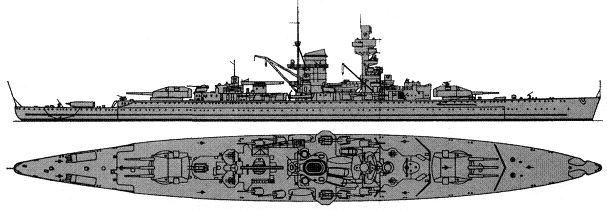
NAVYPEDIA
 Support the project with paypal
Support the project with paypal
Photo

Deutschland 1933
Ships
| Name | No | Yard No | Builder | Laid down | Launched | Comp | Fate |
|---|---|---|---|---|---|---|---|
| Deutschland, 1.1940- Lützow | 219 | Deutsche Werke, Kiel | 5.2.1929 | 19.5.1931 | 1.4.1933 | damaged 16.4.1945, never repaired, scuttled 4.5.1945 | |
| Admiral Scheer | 123 | KMW Wilhelmshaven | 25.6.1931 | 1.4.1933 | 12.11.1934 | sunk 9.4.1945 | |
| Admiral Graf Spee | 125 | KMW Wilhelmshaven | 1.10.1932 | 30.6.1934 | 6.1.1936 | scuttled 17.12.1939 |
Technical data
| Displacement standard, t | Deutschland: 10600 Admiral Scheer: 11550 Admiral Graf Spee: 12100 |
|---|---|
| Displacement full, t | Deutschland: 14290 Admiral Scheer: 15180 Admiral Graf Spee: 16020 |
| Length, m | 181.7 wl 186.0 oa |
| Breadth, m | Deutschland: 20.7 Admiral Scheer: 21.3 Admiral Graf Spee: 21.7 |
| Draught, m | 5.80 mean 7.40 max |
| No of shafts | 2 |
| Machinery | 8 MAN 2-stroke 9-cylinder double action diesels |
| Power, h. p. | 56800 |
| Max speed, kts | 28 |
| Fuel, t | Deutschland: diesel oil 2750 Admiral Scheer: diesel oil 2410 Admiral Graf Spee: diesel oil 2500 |
| Endurance, nm(kts) | Deutschland: 17400(13), 10000(20) Admiral Scheer: 9100(20) Admiral Graf Spee: 8900(20) |
| Armour, mm | Deutschland: belt: 80 - 50, bulkheads: 60, deck: 18 + (45 - 30), anti-torpedo bulkhead: 45, main turrets: 150 - 85, barbettes: 125, shields: 10, CT: 150 - 50 Admiral Scheer: belt: 80 - 50, bulkheads: 50, deck: 18 + (40 - 20), anti-torpedo bulkhead: 40, main turrets: 150 - 85, barbettes: 125, shields: 10, CT: 150 - 50 Admiral Graf Spee: belt: 100, bulkheads: 100, deck: 18 + (70 - 20), anti-torpedo bulkhead: 40, main turrets: 150 - 85, barbettes: 125, shields: 10, CT: 150 - 50 |
| Armament | Deutschland: 2 x 3 - 283/49 SK C/28, 8 x 1 - 149/52 SK C/28, 3 x 1 - 88/45 SK C/13, 2 x 4 - 500 TT Admiral Scheer, Admiral Graf Spee: 2 x 3 - 283/49 SK C/28, 8 x 1 - 149/52 SK C/28, 3 x 2 - 88/72 SK C/31, 4 x 2 - 37/80 SK C/30, 8 x 1 - 20/65 C/30, 2 x 4 - 533 TT |
| Complement | 1150 |
Standard scale images

Admiral Scheer 1940

Lützow 1945

Deutschland 1933

Lützow 1941

Admiral Scheer 1942
Graphics
Project history
In the mid-twenties Germany could start to replace old battleships Braunschweig, Hannover and Elsass which age has exceeded 20 years. Within Versailles limits (10000t displacement) it was possible to built either well defended monitor or coast defence battleship, or cruiser of "Washington" type, however a choice have made in favour of the ship intended for ocean raids. Diesel machinery was instaled on the capital ships for the first time and ensured a huge endurance, became main highlight of the design. Eight 9-cylinder naturally aspirated two-stroke MAN diesels were coupled on two shafts. Choice of main calibre guns was dictated by Versailles limitations, but guns were of new model C/28 (weight of shell of 300kg; a firing range of 36.4km) and placed in two triple turrets fore and aft. They were supplemented with eight 150mm guns C/28 in single shielded mounts. The unique ships, on artillery strength exceeding foreign heavy cruiser (2164kg side salvo weight) and having superiority in speed over contemporary battleships were as a result received. They were officially classified as armoured ships (Panzerschiffe), but are more known as "pocket battleships".
Ships were laid down as "armoured ships A-C". Hull was partially welded, with bulges at most length part, fulfilling role of underwater protection and covering the most part of armoured belt, fitted at 12-13.5° outside. All three ships differed with protection. Main belt began before fore turret and ended behind forecastle break. On Deutschland it had 80mm thickness, tapering to 50mm at lower edge. On Admiral Scheer belt height has been increased, and 50mm plates were transferred upward. The scheme of belt arrangement on Admiral Graf Spee repeated Deutschland, but the thickness made 100mm. Fore and aft belt ends were closed by armour transverse bulkheads. There passed an armoured longitudinal bulkhead in parallel to main belt in 3.7m from centreline between upper and a main deck. Upper deck of all three ships had 18mm protection. Thickness of the main (armoured) deck on Deutschland was 30mm between longitudinal bulkheads and 45mm further to plating; on Scheer was 20 and 40mm respectively; on Admiral Graf Spee it was 20mm between longitudinal bulkheads, 40mm from the upper longitudinal bulkhead to anti-torpedo longitudinal bulkhead, and 30mm between it and belt. Fore end was protected by 17-18mm, and aft end by 45mm armour. Protection of turrets was so: 140mm faces, 80-60mm rears and 85-70mm sides.
Real standard displacement of the ships has exceeded officially declared on 17-25%. Because of diesel machinery "armoured ships" differed by high noisiness and vibration on full speed.
25.11.1939 ships were reclassified to heavy cruisers.
Ship protection (Deutschland)
12-13.5°-inclined main belt extended from point before fore turret to forecastle end and consisted from 2 strips of armor plates. Lower strip was 50mm thick and upper was 80mm abreast machinery and 60mm at ends. Main belt was closed by 60mm bulkheads. Additional 40mm longitudinal bulkhead placed in 3.7m from outer board protected volume between main and upper decks. 2m deep underwater protection included 45mm longitudinal bulkhead and bulges. Hull fwd from main belt had 18mm plating; 1m narrower belt with 30-40mm thickness protected aft part of ship. Flat main deck was 30mm thick between inner armored bulkheads and 45mm between these bulkheads and outer plating. Upper deck was 18mm over citadel and 10-7mm at ship ends. Main turrets had 140mm faces, 80-60mm inclined and 85-70mm vertical sides and 85mm roofs. Barbettes had 125mm protection. CT had 150mm sides and 50mm roof.
Ship protection (Admiral Scheer)
12-13.5°inclined main belt extended from point before fore turret to forecastle end and consisted from 2 strips of armor plates. Upper strip was 50mm thick and lower was 80mm abreast machinery, 65mm abreast fore turret and 50mm aft from aft turret. Main belt was closed by 50mm bulkheads. Additional 40mm longitudinal bulkhead placed in 3.7m from outer board protected volume between main and upper decks. 2m deep underwater protection included 40mm longitudinal bulkhead and bulges. Hull fwd from main belt had 17mm plating; 1m narrower belt with 40mm thickness protected aft part of ship. Flat main deck was 20mm thick between inner armored bulkheads and 40mm between these bulkheads and outer plating. Upper deck was 18mm over citadel and 10-7mm at ship ends. Main turrets had 140mm faces, 80-60mm inclined and 85-70mm vertical sides and 85mm roofs. Barbettes had 125mm protection. CT had 150mm sides and 50mm roof.
Ship protection (Admiral Graf Spee)
12-13.5°inclined 100mm main belt extended from point before fore turret to forecastle end. Main belt was closed by 100mm bulkheads. Additional 40mm longitudinal bulkhead placed in 3.7m from outer board protected volume between main and upper decks. 2m deep underwater protection included 40mm longitudinal bulkhead and bulges. Hull fwd from main belt had 17mm plating; 1m narrower belt with 45mm thickness protected aft part of ship. Flat main deck was 20mm thick between inner armored bulkheads, 40mm between these bulkheads and anti-torpedo bulkheads and 30mm between anti-torpedo bulkheads and outer plating; thickness of main deck over main magazines was 70mm. Upper deck was 18mm over citadel and 10-7mm at ship ends. Main turrets had 140mm faces, 80-60mm inclined and 85-70mm vertical sides and 85mm roofs. Barbettes had 125mm protection. CT had 150mm sides and 50mm roof.
Modernizations
1933 - 1934, Deutschland: - 3 x 1 - 88/45, 2 x 4 - 500 TT; + 3 x 2 - 88/72 SK C/31, 4 x 2 - 37/80 SK C/30, 8 x 1 - 20/65 C/30, 2 x 4 - 533 TT
1934 - 1935, all: + 1 catapult, 2 seaplanes (He 60)
1937, Deutschland: + FuMG 39 Seetakt radar
1938, Admiral Graf Spee: - 3 x 2 - 88/72; + 3 x 2 - 105/60 SK C/33
1939, Deutschland: - FuMG 39 radar; + 2 x 1 - 20/65 C/30, FuMO 22 radar
1939, Admiral Scheer, Admiral Graf Spee: + 2 x 1 - 20/65 C/30, FuMO 22 radar
12/1939, Deutschland: - 10 x 1 - 20/65; + 14 x 1 - 20/65 C/38
1940, Lűtzow, Admiral Scheer: - 3 x 2 - 88/72; + 3 x 2 - 105/60 SK C/33, stem was reconstructed, length oa increased to 187.9 m
late 1940, Admiral Scheer: - 2 x 1 - 20/65, FuMO 22 radar; + FuMO 27 radar
1941, Admiral Scheer: - 8 x 1 - 20/65; + 2 x 4 - 20/65 C/38, 10 x 1 - 20/65 C/38, FuMO 26 radar, FuMB 4 Sumatra, FuMB 7 Timor ECM suites
1942, Lűtzow: - FuMO 22 radar; + 2 x 4 - 20/65 C/38, 1 x 1 - 20/65 C/38, FuMO 26 radar, FuMB 4 Sumatra, FuMB 7 Timor ECM suites
summer 1944, Admiral Scheer: + 2 x 4 - 20/65 C/38
8/1944, Lűtzow: - 2 x 2 - 37/80, 7 x 1 - 20/65; + 2 x 1 - 40/56 FlaK 28, 1 x 4 - 20/65 C/38, 6 x 2 - 20/65 C/38
9/1944, Lűtzow: + 2 x 1 - 40/56 FlaK 28
late 1944, Lűtzow: + 2 x 1 - 40/56 FlaK 28
late 1944, Admiral Scheer: - 4 x 2 - 37/80; + 4 x 1 - 40/56 FlaK 28
1945, Lűtzow: + 4 x 1 - 20/65 C/38
1945, Admiral Scheer: - 10 x 1 - 20/65; + 4 x 1 - 40/56 Flak 28, 2 x 4 - 20/65 C/38, 9 x 2 - 20/65 C/38
Naval service
All three actively acted at coast of Spain in 1936-1938; Deutschland 29.5.1937 was damaged by Spanish Republican aircraft. Admiral Graf Spee 13.12.1939 was damaged in battle against British cruisers Exeter, Ajax and Achilles at a mouth of La Plata, 17.12.1939 she was scuttled on shallow water at Montevideo to avoid capture by superior forces. Lützow 11.4.1940 was torpedoed by British submarine Spearfish in Kattegat, repair lasted 6 months, 13.6.1941 she was damaged by British torpedo bomber in Skagerrack and repaired 7 months, 3.7.1942 she was damaged as a result of navigating accident in Ufut-fiord and was under repair 3 months, 16.4.1945 she was hard damaged by British heavy bombers at Swinemünde, ran aground, but continued to use her artillery, was blown up by own crew 4.5.1945. Later she was salvaged by Soviet Navy in September 1946 and sunk as target 22.7.1947. Admiral Scheer was capsized and sunk 9.4.1945 during raid of British aircraft to Kiel after 5 direct hits of heavy air bombs.
 HOME
HOME FIGHTING SHIPS OF THE WORLD
FIGHTING SHIPS OF THE WORLD GERMANY
GERMANY CRUISERS
CRUISERS DEUTSCHLAND heavy cruisers (1933 - 1936)
DEUTSCHLAND heavy cruisers (1933 - 1936)

